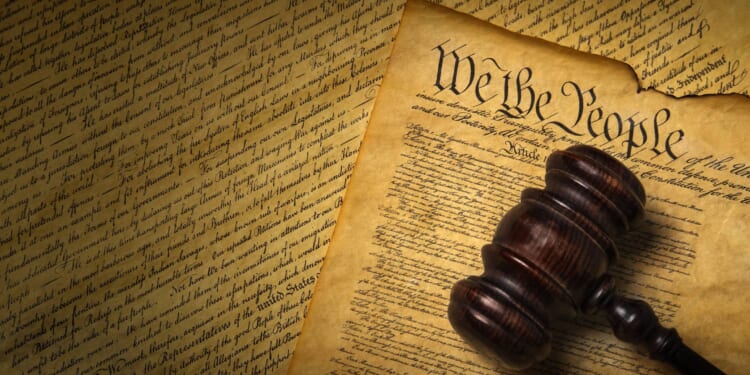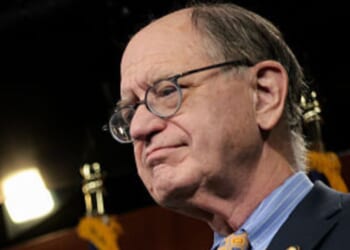The rule and role of law.
Jesse Merriam has inaugurated this symposium on the future of the conservative legal movement with a provocative essay arguing that the movement needs to reassess itself in light of our current political and cultural moment. He argues that it should shed its technocratic “focus on how precedents are interpreted and distinguished” in favor of a broader project “that conceives of law as a way to sustain the American way of life.” Legal conservatism, Merriam continues, should “develop a constitutional morality that reflects the larger project…of constitutional and…civilizational restoration.” He does not want to abandon originalism but says that the conservative legal movement needs to mount a positive project to meet today’s considerable challenges.
I agree.
In order to clarify Merriam’s argument, it is important to point out that the movement has always needed, if it has not quite always had, at least three separate but overlapping projects.
The first, loosely speaking, is about the rule of law, and particularly what the Constitution has to do with that principle. A second project is about the role of law. How should law serve conservative ends? That project has always been related to the substantive requirements of the Constitution, but necessarily transcends them. The focus here has been on criminal law, public accommodations law, and civil rights law, and has always been more closely connected to political conservatism. The third project concerns constitutionalism more broadly: What are the deeper constitutional principles underlying the American legal order? Those are the principles that ought to guide the legislation of the second project—political conservatism—but which are not exclusively found within the four corners of America’s written Constitution.
I will vigorously defend the first project, with originalism as its central component, because that project is inherent in political conservatism, and much more work remains to be done on that front. Then I will address the broader aims Merriam advocates and how the three projects of the conservative legal movement relate to one another. My overarching arguments are that (1) originalism conserves the Founding; (2) originalism enables political conservatism, and there is much more originalism can do in this regard; and (3) constitutionalism is more than just the Constitution itself, and conservatives need to relearn how to think about constitutionalism in this broader sense.
Defending Originalism
Professor Merriam does not want to abandon originalism, though his disappointment with its narrow focus is obvious, and he does not quite explain why originalism is worth preserving. The answer, I think, is fundamental to political conservatism. What is it that conservatives in America are interested in conserving? They are interested, at least in part, in conserving the American Founding, which includes our Founding principles. Although the written text of the Constitution is not the sum total of Founding-era principles—nor is it the sum total of the nation’s “constitutional morality”—the Constitution the Framers wrote certainly advanced the principles they advocated. And originalism is the interpretive doctrine that gives legal effect to their Constitution, and which treats the original meaning of their Constitution as the law today. It is what makes their Constitution our Constitution.
To be sure, this only gets us so far toward Merriam’s project of renewal. That is because constitutions are necessarily somewhat general. The very purpose of a political constitution, as the Founding generation almost universally understood, was to establish a framework for government that would preserve natural liberty while also giving up a necessary degree of that liberty. The aim was human happiness and both the common and individual good. These objectives always require the preservation of liberty, which is essential to happiness. But restraints on liberty are also necessary to happiness, whether because liberty is insecure in the state of nature or because human beings are naturally social and require social relations and laws to govern those relations.
The Founders’ Constitution struck this balance well, enabling democratic self-government while preserving large measures of natural liberty. It did not compel virtue, but created the conditions in which virtue could flourish. The balance struck was not the only conceivable balance suitable for a free society. But to the extent we think the Constitution got the most important things right, originalism conserves the balance and the principles the Framers sought to advance. That is why originalism is not only consistent with but also essential to modern-day political conservatism.
Crashing Through the Wall
Homing in on the task of overturning non-originalist precedents—a task that Merriam discounts as technocratic—is also essential to political conservatism. It’s true, as Merriam says, that there are still millions of abortions. But originalism eliminated the central legal roadblock to putting an end to abortions.
Progressives have preferred to constitutionalize rights because those rights would otherwise be lost at the ballot box. That is not a criticism: all of the rights conservatives prefer—speech, religion, guns, due process, etc.—would also be insecure if subjected to too much democratic politics, which is why they are secured in the written Constitution. The difference is that the latter rights are traceable to the Constitution’s written text, while the former are not.
The point is that once we eliminate those roadblocks, the work of political conservatism can begin. That’s not to say that political conservatism is unrelated to law. A politically conservative victory, after all, would be achieved after a legislature passed legal prohibitions on abortion. A politically conservative victory on marriage might result in different legal definitions of marriage. And so forth. It is obvious to the point of being unhelpful to say in this respect that legal conservatism and political conservatism must converge. But if the point is to develop an approach to constitutional interpretation that somehow constitutionalizes these conservative results, that is another matter entirely, one that Merriam does not seem to advocate.
There is also much more that the technocratic, originalist approach can accomplish to advance political conservatism.
Take civil rights law, for example, which is of central concern to Merriam. The Supreme Court’s recent decision holding affirmative action unconstitutional allows conservatives the opportunity to reinterpret the existing civil rights laws to prevent their greatest excesses. Resurrecting the original meaning of the 14th Amendment’s Privileges or Immunities Clause and of the Commerce Clause could advance Merriam’s civil rights project by refocusing the law on state-based discrimination, as well as discrimination in truly public accommodations, and limiting at least federal interference with private associational rights. To take a related example, progressive legal interpretations have foisted insidious disparate impact rules on our nation, and legal interpretations can undo them. Adhering to the original meaning of the Constitution and Congress’s civil rights statutes would go a long way to remedying the ills under which Merriam says we continue to labor.
More Than the Text
Our small-c constitutional discourse, of course, also has something to say about these matters. Merriam writes that the Lochner era, for example, involved much more than just Supreme Court decisions, but also included a broader understanding of the role of law in a system centered on individual rights and autonomy. I agree that the conservative legal movement should now start to grapple with this broader question. What is the role of law, or what should it be, given our goals? How can law promote human flourishing and the common good? Should law regulate marriage, for example, and for what purposes? And should it regulate private discrimination to the extent it does today—one of Merriam’s central concerns?
The Constitution sometimes touches directly on political questions, but not always. It guarantees the free exercise of religion, which is obviously essential to the conservative political project, but often it will not compel any particular answer. One can draw on classical legal theory and natural law to conclude that a state should be free to prohibit same-sex marriage, but it is a stretch to conclude from that proposition that the Constitution prohibits a state legislature from allowing same-sex marriage.
Merriam is right, however, to focus on what he calls a “constitutional morality.” Even if the written text of the Constitution does not compel a particular result, the written Constitution is not the sum total of a nation’s constitutional principles. Those broader principles are inherent in America’s history and traditions.
One example of laws or practices that might violate the nation’s small-c constitution are those abridging academic freedom. There is generally no First Amendment right to such freedom, but few principles are more ingrained in our constitutional imagination (and possibly constitutional history, although that is less clear) than academic freedom. Another such constitutional principle, less salient today, might be freedom of contract.
The critical point is that such constitutional principles, absent constraints in the written Constitution, are not legally operative against contrary acts of legislatures. The American revolutionaries believed that Parliament’s oppressive acts were perfectly legal under the British conception of parliamentary supremacy, perhaps even constitutional. But it did not follow that they were consistent with the fundamental law—that is, the still higher law of the “ancient constitution” as evidenced by nature, longstanding tradition and practice, and prior constitutional struggles.
If Merriam seeks nothing more than to include this older mode of thinking about constitutionalism within the framework of America’s written Constitution, few should disagree with him. But all must recognize the limitations of that approach for creating judicially enforceable rules that have heretofore been the bread and butter of the conservative legal movement.

















